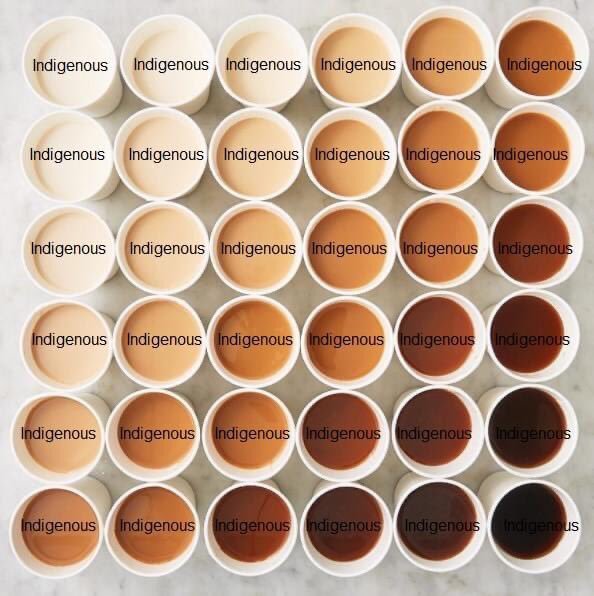Indigenous Native American people come in many skin color shades or tones. You can be Native American with any skin color shade.
Take a moment to look at this video discussing ‘White Passing’ by an Indigenous person. Indigenous “Racial Shifting” is another term to become familiar with. More here: Identity is Not Math / August 27, 2025 / JACOB AVERY, PHD
Native American racial heritage can come from the paternal side or the maternal side or both.
Taffy Abel’s Native American skin color was lighter and in the upper left quadrant. His paternal side heritage was European American (White) and his maternal side heritage was (Indigenous) Native American Ojibwe (Chippewa) from Michigan and Canada.
Taffy Abel can be referred to as an Ojibwe and Metis. Metis: The offspring of an Indigenous American and a person of European ancestry.
A New York Rangers teammate of Taffy Abel referred to him as ‘Fair Complected’.
Frank Boucher said: “Taffy, a big fair-complexioned man was nearly as bald as Ching. But he was quick and light as a feather on his feet, something like Jackie Gleason.”
Individuals of Ojibwe descent can have a wide range of complexions, including fair skin.
Taffy’s lighter skin color allowed him to pass as a White to: 1. escape being sent to a Indian Residential Boarding School in 1905 and 2. to get entry into the 1924 WINTER OLYMPICS and 3. to get entry in the Whites only N.H.L. in 1926.
It was a matter of survival. To survive as a Native American in the early 1900s was difficult. It was a choice to Run - Hide - Pass.
In those racist times both African Americans and Native Americans used Racial Passing to escape discrimination.
For many years until 1999, Crayola, the Crayon manufacturer actually had a racist inspired Crayon called “Indian Red”. After much protest they renamed it “Chestnut”. Read the AP & Chicago Tribune story and more here and here and here.
Up to the 1950 census, how a person’s race was classified was often based entirely upon the perception of the Census enumerator. “If a different census taker comes to the door and they leave their paper bag at home, then maybe they’re Indian that year,” Shapiro said, referring to the idea that a person’s race could be determined based on whether their skin color was darker than a paper bag.
According to Shapiro, Native people often went underground to evade persecution. They would sometimes hide when census takers would come, Shapiro explained, changing their appearance, making strategic marriages, and employing other strategies to hide their indigeneity in the hopes they wouldn’t be exiled. This affected the accuracy and quality of the census counts.
Refer to the SKIN COLOR MAP Skin plays a twin role with respect to the sun: 1. protection from excessive UV radiation and 2. absorption of enough sunlight to trigger the production of vitamin D.
Skin Color Has A Correlation with UV radiation: Indigenous populations living in areas with higher levels of UV radiation (nearer the equator such as Texas) tended to have darker skin, while those in higher latitudes to the North (such as Michigan or Canada) with less intense UV radiation had lighter skin.
It is believed that European representations of Native American people as violent date back to as early as 1591, when engraver Theodor DeBry engraved and published artist Jacques LeMoyne’s 1564-65 drawing of Indian scalping.
Furthermore, from the 17th to the 19th centuries, white observers portrayed Native Americans intent on “savage war” more violent than “civilized” combat of white European and American governments.
Wild West shows, performed across North America and Europe from the late 1800s into the 20th century, dramatized Native American attacks on stagecoaches and cabins as well as mock battles between cavalry and Indians.
William “Buffalo Bill” Cody and other white showmen drew huge audiences. These shows, and related influences, inspired white filmmakers to produce Westerns depicting hordes of Native Americans attacking white Euro-Americans.
As a matter of fact, many Native Americans were taken captive by white Euro-Americans, tortured, incarcerated, murdered, and expelled into slavery. And later into the infamous Indian Residential Boarding Schools who followed the principles of ‘Kill the Indian - Save the Man’.
Because white Euro-Americans colonists threatened Native Americans peoples, many resisted mightily to defend their families and homelands.



